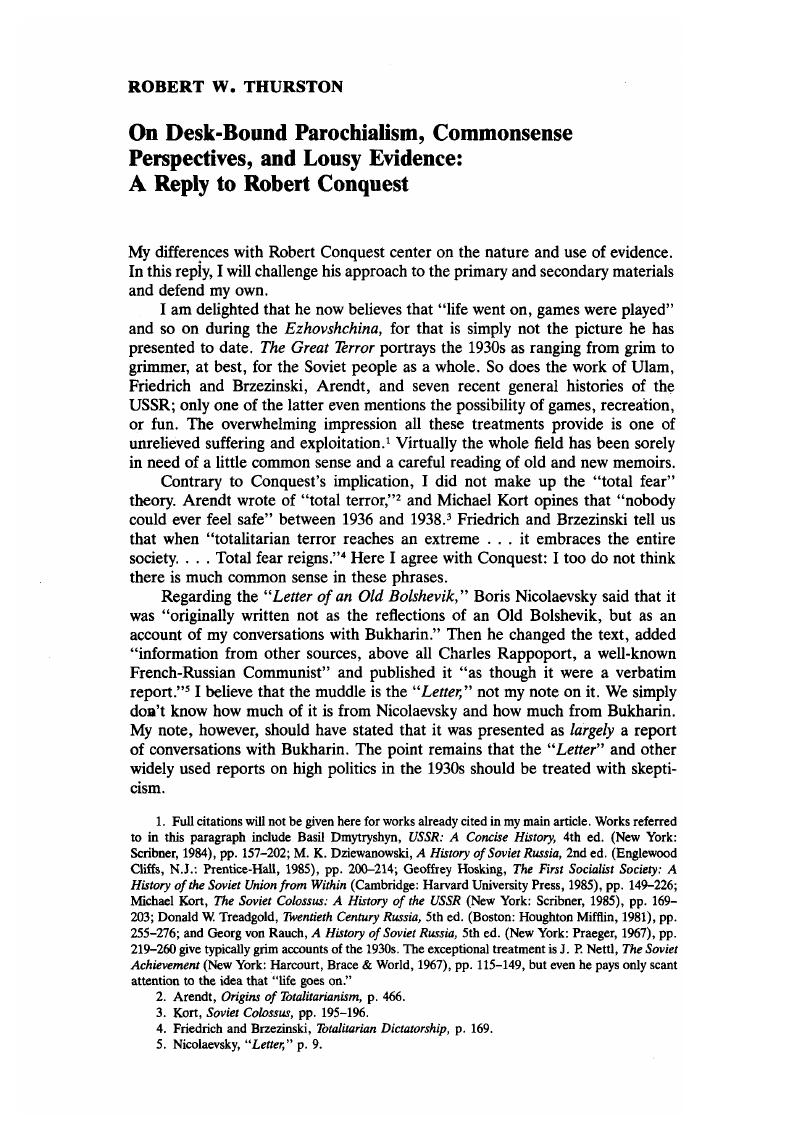Published online by Cambridge University Press: 27 January 2017

1. Full citations will not be given here for works already cited in my main article. Works referredto in this paragraph include Dmytryshyn, Basil, USSR: A Concise History, 4th ed. (New York: Scribner, 1984, pp. 157–202 Google Scholar; Dziewanowski, M. K., A History of Soviet Russia, 2nd ed. (Englewood Cliffs, N.J.: Prentice-Hall, 1985), pp. 200–214 Google Scholar; Hosking, Geoffrey, The First Socialist Society: A History of the Soviet Union from Within (Cambridge: Harvard University Press, 1985, pp. 149–226 Google Scholar; Kort, Michael, The Soviet Colossus: A History of the USSR (New York: Scribner, 1985, pp. 169–203 Google Scholar; Treadgold, Donald W., Twentieth Century Russia, 5th ed. (Boston: Houghton Mifflin, 1981), pp.255–276 Google Scholar; and von Rauch, Georg, A History of Soviet Russia, 5th ed. (New York: Praeger, 1967), pp.219–260 Google Scholar give typically grim accounts of the 1930s. The exceptional treatment is Nettl, J. P., The Soviet Achievement (New York: Harcourt, Brace & World, 1967), pp. 115–149 Google Scholar, but even he pays only scantattention to the idea that “life goes on. “
2. Arendt, Origins of Totalitarianism, p. 466.
3. Kort, Soviet Colossus, pp. 195–196.
4. Friedrich and Brzezinski, Totalitarian Dictatorship, p. 169.
5. Nicolaevsky, “Letter,” p. 9.
6. Kosterina, The Diary of Nina Kosterina, pp. 161 and 167. See also Orlova, Memoirs, for thewide range of literature she read in the 1930s.
7. Stalin, Socheniia XIV: 158, 163, 263, and 273.
8. Ibid. XIV: 232–234; this example is from a speech to the Central Committee plenum on 5 March 1937.
9. Weissberg, Accused, pp. 318–324. For the sake of accuracy, it should be noted that Weissbergsaid two million, not one million, ordinary criminals.
10. Sakharov, Andrei D., Progress, Coexistence, and Intellectual Freedom, ed. Salisbury, Harrison E. (New York: Norton, 1968), p. 55 Google Scholar. It is possible that Sakharov, having attained very highrank in Soviet society, received his information from well-informed officials, but we do not know hissources or their reliability.
11. Rigby, Communist Party Membership, p. 212.
12. Pravda, 26 January 1938, p. 1, urged party members to “rehabilitate those unjustly excluded[from the party], severely punish the slanderers!” This line suggests that all expelled had not beenarrested, as there is no record anyone was released from prison or a camp at this time to go beforea party review board.
13. See, for example, Vladimir and Evdokiia Petrov, Empire of Fear, p. 67; Barmine, One Who Survived, p. 241, and Orlova, Memoirs, p. 181.
14. Beck and Godin, Russian Purge, pp. 98–136.
15. I have been unable to track down the Vinnitsa story to my satisfaction. It seems problematical in some respects. Apparently the incident first surfaced in the west in an account by one of the nonreturnees in the Harvard survey. He reported that relatives identified bodies by their underwear; often names were sewn into the garments. See Brzezinski, Permanent Purge, p. 109. But I wonder why a peasant woman would have sewn names into clothing, since laundry was a family, not a commercial, affair. Certainly there is no precise indication in this account of how many victims were peasants. Brzezinski also cites two other reports from the early 1950s that have been unavailable to me. The Great Terror gives no sources at all for the story.
16. Beck and Godin, Russian Purge, p. 33.
17. Weissberg, Accused, p. 324.
18. Reitlinger, Gerald, The House Built on Sand: The Conflicts of German Policy in Russia, 1939–1945 (New York: Viking, 1960, p. 229 Google Scholar. As the article noted, it is significant that the Germans reported a higher level of hostility when they crossed the 1939 frontier into the “old” Soviet Union.
19. Werth, Alexander, Russia at War: 1941–1945 (New York: Dutton, 1964, pp. 647–648 Google Scholar.
20. Wheatcroft, “On Assessing the Size,” p. 283.
21. Weissberg, Accused, pp. 409–412.
22. Herling, Gustaw, A World Apart, trans. Maiek, Joseph (New York: New American Library, 1952, p. 18 Google Scholar.
23. Quoted in Brzezinski, Permanent Purge, p. 98; my italics.
24. Arendt, Origins of Totalitarianism, p. 467.
25. Compare Stalin, Sochineniia, pp. 140–142 and 178–179 with p. 189.
26. Ibid., pp. 327–402, especially 346, 367, 368, 371, 377, 395–398, and 400.
27. Solomon, “Soviet Criminal Justice,” pp. 29–31.